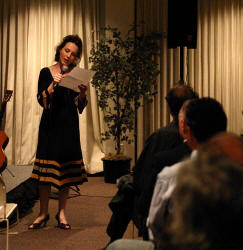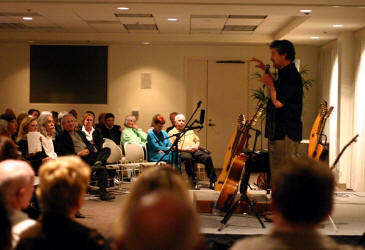The Museum of Making Music presents
Harp Guitars: Passion, Imagination, Artistry
Jan 15 - July 31, 2007
Report by Gregg Miner
| This spectacular exhibit - the world's first public
museum display of harp guitars is a presentation by the NAMM-supported
Museum of Making Music in Carlsbad, California, and is an exciting collaboration between
the devoted Museum staff, guitar guru Rick Turner, and myself.
Besides including nearly my entire harp guitar collection, other
incredible and valuable one-of-a-kind instruments were loaned by several
donors (see list below).
February 3rd marked the Grand Opening, with a gala evening featuring Stephen Bennett in the first of three concerts.
|
| Credits that appeared at the end of the exhibit include everyone that made this possible. In my list of repairmen (above and beyond the call of duty) is Mario Martello, who did an extensive major museum-quality restoration on my Stumcke in less than a month. It may have been his last major repair, as he passed away in October of 2006. I only then learned that he and I share the same birthday. |
 |
 |
|
Museum director Carolyn Grant introduced the evening. |
I did a quick re-cap of 350 years of harp guitar history...a quick explanation of evolution in Europe... |
| Thus ends the harp guitar concert series at the world's first special engagement harp guitar exhibit, which will close our "Year of the Harp Guitar" at the end of July. Thanks to all who have visited and supported this unprecedented effort! |
Visit the Museum of Making Music's Harp Guitar Exhibition Overview
|
If you enjoyed this page, or found it useful for research, please consider supporting Harpguitars.net so that this information will be available for others like you and to future generations. Thanks! |
|
|
|
All Site Contents Copyright © Gregg Miner, 2004,2005,2006,2007,2008,2009,2010,2011. All Rights Reserved. Copyright and Fair Use of material and use of images: See Copyright and Fair Use policy. |